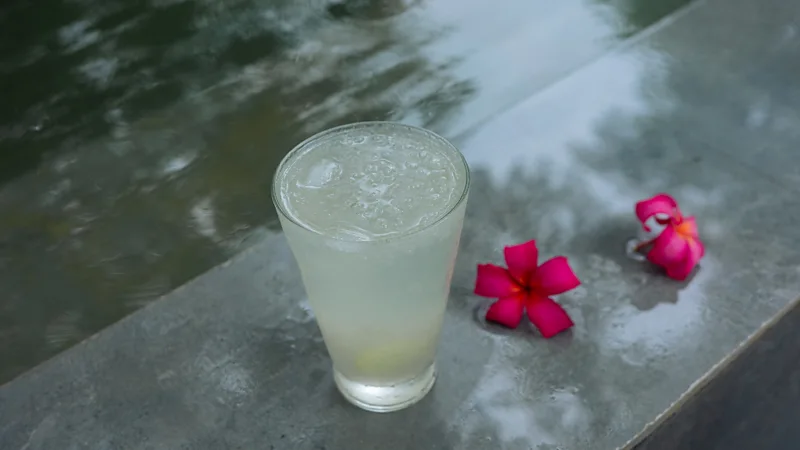Gond Katira: A natural way to cool down in India's scorching summers
This year, when India experienced its longest ever heatwave, locals turned to cool drinks like never before.

Caught in a sudden downpour on a July afternoon, I carefully walked down the crowded, muddy sidewalk in old Delhi to reach Khari Baoli, Asia's largest wholesale spice market. I soon found what I was looking for in an array of bowls heaped with spices at the entrance of a narrow shop. Here, small, uneven, translucent crystals, their off-white colour infused with the slightest rusty hue, lay in a cardboard tray. A small plastic sign set among the crystals read, "Rs 120 [£1.12] for 250g, Gond Katira".
My curiosity about this lesser-known ingredient began some years ago on a sweltering summer day during a visit to a friend's house. Her mother offered me a popular drink with a twist: a glass of lemonade but with small pieces of white jelly in it. She told me it had a cool taseer (the cooling or warming property of a food) that reduces body heat. The tasteless and odourless jelly, made from soaked crystals, was gond katira, or tragacanth gum.
Tragacanth gum can be derived from more than 2,000 plant species of the Astragalus genus, found from Greece to south-western Asia, with Iran and Turkey being the top producers. When incisions are made on the roots and bark of a plant, gum oozes out of them in the form of a long curving string or ribbon that hardens rapidly. This dried gum is collected and processed into flakes and powder.
One of its main components is tragacanthin, which is soluble in water and swells to form a gel-like structure; because of this, tragacanth gum is widely used in the food industry as a thickener and emulsifier. It is added to baking mixes, relishes, condiments, oils, sauces, fruit juices and meat. It is also used in antibacterial, anti-cancer, anti-inflammatory and antioxidant treatments in the pharmaceutical industry.
Gond katira has also long been considered a herbal remedy. "It has been used by Unani [a traditional medicine system practiced in South Asia] physicians for centuries as it has the ability to cool the body, improve skin texture and liver enzymes and boost immunity," explained Dr Syed MM Ameen, a Unani doctor based in Chennai.
Ameen added that its benefits are mentioned in the Canon of Medicine, compiled by the 11th-Century Persian physician Avicenna, which is still used in Unani medical colleges; and in the Indian government's National Formulary of Unani Medicines for its usage as a single drug and in compounded medications to treat liver and respiratory diseases.
Did You Know?
The use of this gum in remedies is not limited to India. It is also an ingredient in Fisherman's Friend lozenges, a popular, old-fashioned cure for coughs and colds in the US and UK.
Although gond katira is mainly produced and exported by Iran and Turkey, it is considered a traditional household ingredient in India, especially by older people, with its usage spanning from Delhi and Punjab in northern India to Andhra Pradesh and Tamil Nadu in the south. And this year, when India experienced its longest ever heatwave, locals turned to cool drinks like never before. In fact, Google searches for "gond katira" peaked between 19-25 May, when temperatures were between 41-45C.
India is home to a huge variety of sherbet, a popular cold beverage made with cordial from fruits, flowers and herbs. In many homes, people also add gond katira to sherbet during the summer for its cooling properties. Some also consume the soaked jelly on its own, while others add it to milk, milkshakes, lassi (a yoghurt-based beverage), yoghurt and desserts such as kheer, a popular rice pudding eaten in South Asia, to reduce body heat, provide hydration and as a preventive measure against heatstroke.
Harjeet Kaur, a freelance writer and blogger, grew up in Vijaywada in the southern state of Andhra Pradesh where the temperature can reach 49C in the summers. As a child, her mother would give her gond katira on summer mornings to keep her cool and hydrated.
"My mother used to lug gond katira all the way from Delhi and store it. She made a drink by mixing Rooh Afza (a popular sherbet in South Asia) with water or milk, sugar, gond katira and ice. I enjoyed it so much that I continue to drink it to this day," she said, noting that she drinks it for breakfast in summer, mixing the jelly with water, jaggery and a slice of lemon. "As soon as you drink it, you feel your insides cooling down."
How to make gond katira jelly
Rinse a tablespoon of gond katira crystals and soak them in 300 ml of water. Leave it for at least four hours or overnight. It will turn into a white jelly. If you see any debris, rinse again. Now you can add this jelly to drinks and desserts.
Kaur laments that the younger generation has forgotten about traditional and seasonal foods like gond katira. However, in the last few years, she has introduced several friends and neighbours to this gum to help relieve them from extreme heat. And since the Covid-19 pandemic, there has been a rise in Indian consumers eating more consciously and taking an interest in natural foods, which has resulted in a growing popularity of foods such as gond katira among young people.
"We are seeing an increase in the demand for gond katira because people are learning about it through social media," said Chaitanya Jaggi, whose family owns Om Sai Ram, a spice shop in Khari Baoli market. His sales of gond katira spike between March and August, when heat and humidity are peaking in many parts of India.
A quick Instagram search shows how food bloggers, doctors, dieticians and fitness enthusiasts have shared recipes of summer drinks and desserts made with gond katira in recent months. Sangeeta Khanna, a nutritional consultant and culinary trainer based in Delhi, first blogged about gond katira in 2016. Ever since, she has seen a growing interest in its health benefits and cooling properties through comments on her Instagram posts showing recipes of sherbet, dessert and breakfast bowls made with the jelly.
Gond katira’s gelatinous texture makes it strikingly similar to bubble or boba tea, which is also growing in popularity in Indian cities. In fact, Khanna makes a bubble tea with brewed black tea, chilled milk and honey in which she replaces the sago pearls with white jelly.
"Gond katira contains soluble fibre which acts like a prebiotic and helps in the proliferation of gut flora. Since it holds water for a long time, it keeps hydrating your body for a long duration," explained Khanna, who notes that gond katira was a common summer ingredient in north Indian households until the mid-'80s when packaged cold drinks entered the Indian market. "It is a very poorly acknowledged ingredient," she added.
Abhilasha Jain owns Marwadi Khana, a catering service in Gurgaon that specialises in Rajasthani vegetarian cuisine. She grew up in Bhilwara in the desert state of Rajasthan where she first discovered gond katira after getting heat stroke as a young girl. But over the years, this ingredient faded from her life. Five years ago, during a hotter-than-usual summer, she received gond katira from her mother and now she uses it regularly. "We drink it with different kinds of sherbet – khus (vetiver), sandalwood and white rose," she said. Sometimes, she also mixes gond katira with rabdi, a sweet made with condensed milk, sugar or jaggery, spices and nuts.
Gond katira is also a part of street food across the country. In Punjab, it is included in shikanji (lemonade) sold in street carts. In Madurai in Tamil Nadu, gond katira is called badam pisin (which translates to almond gum, although it is not made from almond) and is used in a popular beverage called jigarthanda that is made with milk and nannari syrup (made from the roots of the Indian sarsaparilla, a herb used in Ayurvedic medicine for its cooling properties). In the cities of Vijayawada and Rajamahendravaram in Andhra Pradesh, the gum is called katora and can be found in a drink called sugandhi katora, made with nannari syrup, basil seeds, water or soda or milk.
Once a household ingredient that was forgotten and is now seeing a revival, gond katira has yet to make its way into restaurant menus. However, entrepreneurs like Jain are introducing it to people in small events. "I served a rose gond katira sherbet for a high-end, sit-down lunch for 120 people. They were really impressed. They felt it was new and nice," she said.
When she first posted about this gum on social media, Jain saw that many were confused between gond (acacia gum) and gond katira. While gond is better known because it is used in sweets and consumed in winter for its warming properties, many people still don't know about gond katira.
Where to find gond katira
The gum can be found both online and in small neighbourhood kirana (grocery) stores in villages and organic stores and supermarkets in cities across India. The price ranges from Rs 250 (£2.34) to 500 (£4.68) per kg depending on its quality and the size and colour of the crystals.
"This year it was so hot. I am surprised to see so many people using gond katira now… Thanks to social media, our traditional foods that so many people don't know about are now being shared," she said.
As temperatures continue to soar each summer in India, a time-tested, humble ingredient like gond katira can provide an easy, affordable and delicious way to cool the body and make the heat a little more bearable.
-bbc







